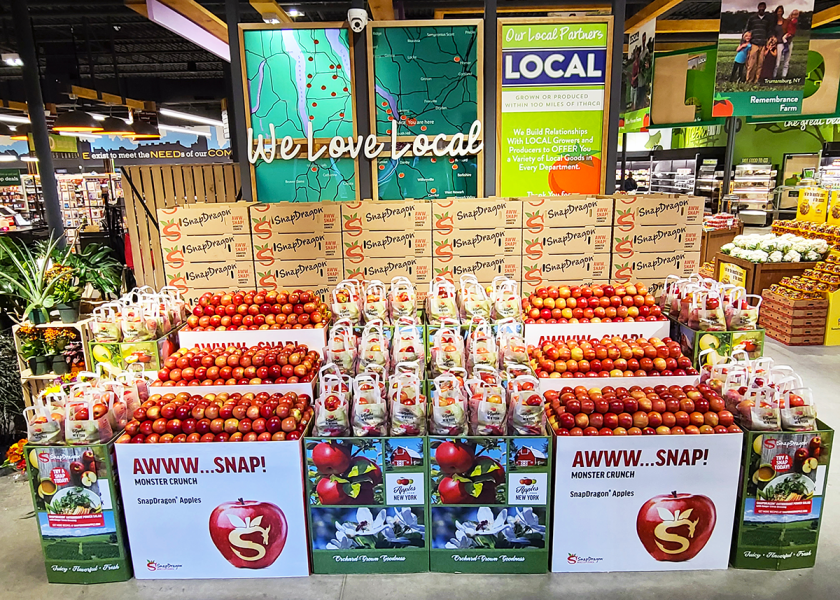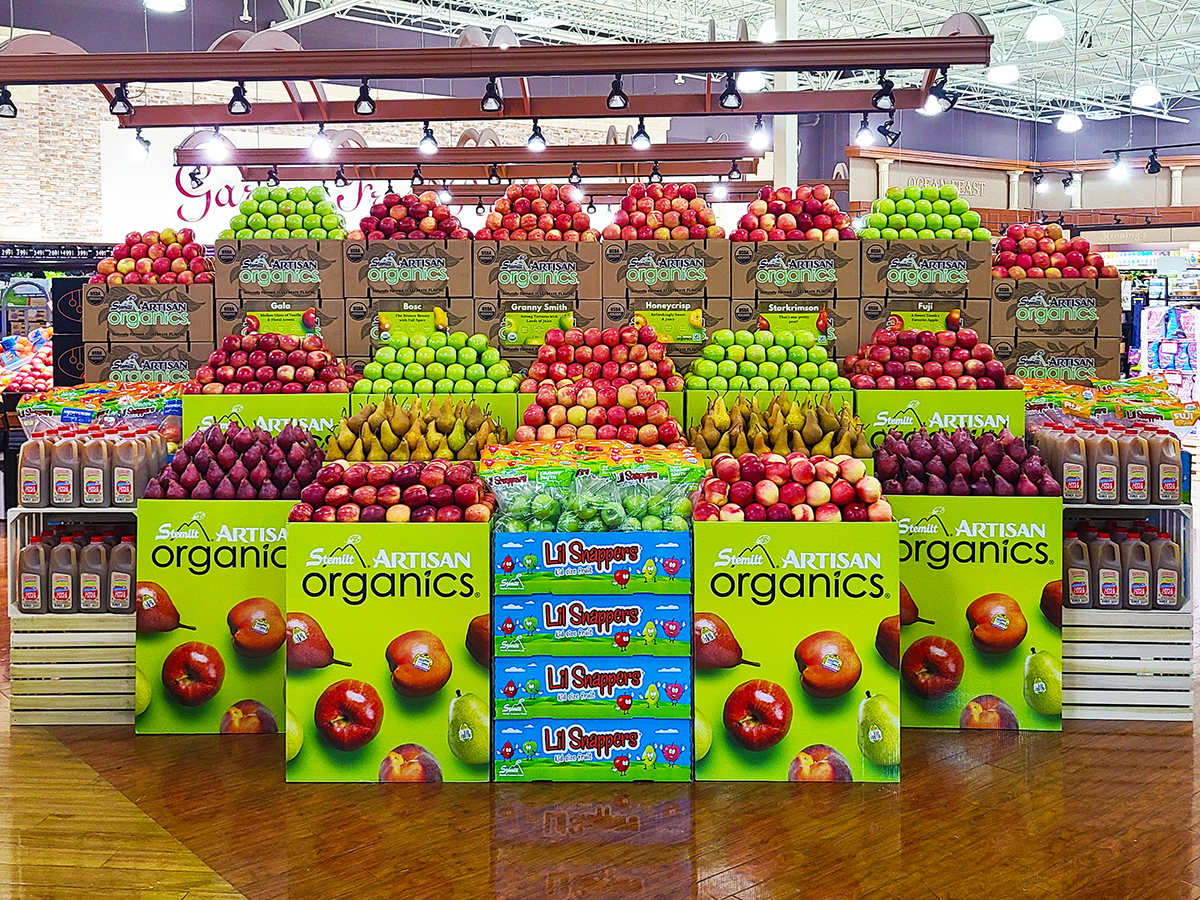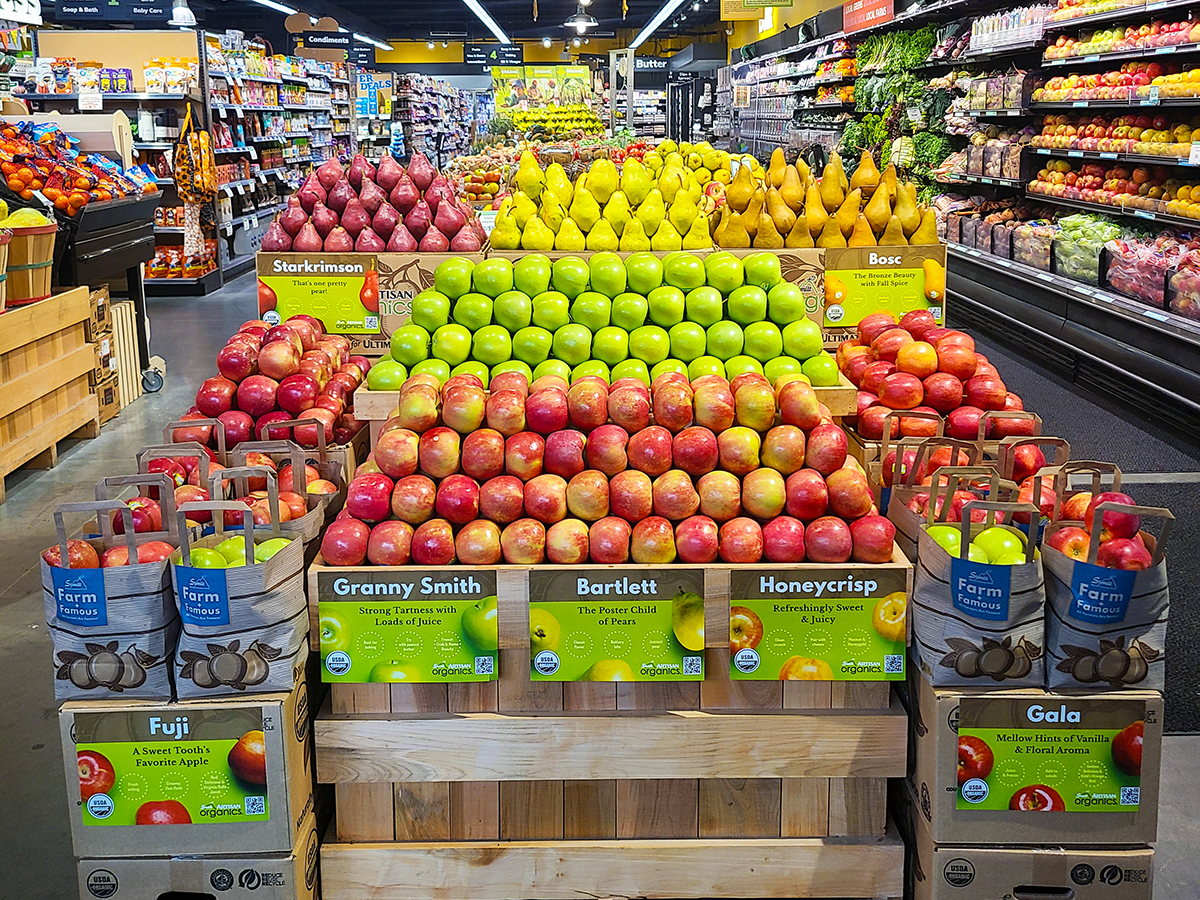How to build impactful apple displays that help sales

Ah, yes, the beautiful apple — a vintage symbol of the produce department and a commodity that drives serious volume through the registers.
The apple is super versatile and is a piece of fruit that has a flavor profile fit for everyone. From sweet to tart and everything in between, there truly is an apple for every cart. From old standbys such as red delicious to consumers’ new favorites such as the SugarBee, there is no shortage of apple varieties to offer your customers and to try in your apple sections.
There has indeed been solid growth in the apple category over the years. While the consumer favorites and trends are still seemingly leaning towards anything Honeycrisp, some of the newer “club” or grower-shipper proprietary varieties, such as Envy, Opal, Cosmic Crisp, Ruby Frost, SnapDragon and Aura, have made their way onto apple counters and into customers’ shopping carts.
These club varieties continue to steadily gain market share as they satisfy the consumer's desire to try new things and offer different flavor profiles fit for any apple fanatic’s taste buds. As more varieties of apples continue to come into the marketplace, this is the area that I believe will continue to boost the apple category as the industry moves forward. It is all about getting your customers to try new things, and the best way to do that is through merchandising and consumer education.

Maximize merchandising
Great apple sales start with great apple merchandising. Apple sections, however, can sometimes be drawn together and blend, as so many of the apples that are available are red or have various shades of red in them.
This is where sound merchandising will help you separate the different apple varieties for your customers and lead to the best category sales for your department and store.
The easiest way to separate varieties across your apple sections is to use the distinct colors that some apples have as color breaks. For example, granny smith, golden delicious, Aura and Opal apples offer green and yellow combo colors to spread out across your displays and are easy to use as color breaks.
There are times, however, when you will not have any choice but to put some red-colored apples next to each other. In these cases, the use of the overall color and shape of the fruit will make a difference in helping a customer to differentiate varieties. Dark red, red delicious or Cosmic Crisp, for instance, offers a different look next to a Honeycrisp or Pink Lady; the green blush on a mcintosh would work next to a gala or fuji.
All predominantly red apples are close to the same color, but most customers would be able to separate the varieties by looking at the variances in color. Different counter types and display fixtures also come into play, as some of these, such as bin pods or risers, will help differentiate varieties by themselves.
Another great way to break up color in apples is to use pears within your sets. These add variety, depth and color and are seasonal with apples.

Variety variables
With so many different varieties of apples available, which ones and how many different types of apples should you carry? The simple answer is that this is completely a matter of preference.
I personally like a department with a lot of variety, but space, sales goals, fear of shrink and location are all real factors when making such decisions. I have worked with stores that carry the basic five or six varieties all the way up to 40 types of apples in peak local season.
While having 40 varieties of apples on display might confuse a customer, it really makes for an impressive impact display and offers an incredible amount of opportunity for a customer to try new things. I believe 12 to 14 varieties of apples in the heart of apple season is a good target number, and that will ebb and flow based on time of year and availability of fruit. It is not too overwhelming of a number for a customer, while adding an opportunity for an impressive variety of fruit to choose from.
Some staples to think about are the regular varieties that you see in a lot of departments: red delicious, golden delicious, granny smith, Honeycrisp, gala, fuji and mcintosh, etc.; then sprinkle in some of the club and proprietary varieties mentioned earlier.
Be well rounded in selection and well versed in which types of apples are best for baking — and be sure to highlight these on your counters for the customers looking for the perfect apples for pies. Printing out recipes to have at your displays is a great idea that can spur impulse sales. POS signage for each variety is a good way to show customers what they are buying and educate them on the flavor profiles.
Bagged and bulk
Offering apples in both bags and bulk targets two different types of customers.
Bagged fruit is generally smaller in size and is perfect for a quick snack and for school lunch boxes. It also offers a convenience pack for your customers to grab and go, often at a value per pound, and consumers, especially now, are looking for value in anything they purchase.
Bagged also is a great opportunity to increase organic offerings and variety in your department without the fear of mis-rings at the registers or co-mingling on the counters.

Totes, totes, totes!
Similar in concept to bagged fruit, but different in visuals, is offering tote bags of apples in your sections and displays. One of the easiest ways to sell apples is by toting them up and putting them in your displays. For me personally, it has been a proven formula for success, and it does not matter what season it is.
For starters, especially in the fall, totes add a farm market feel to any display that screams old-school merchandising. They are convenient for customers to pick up quickly, and a shopper grabbing a tote bag of apples — depending on the variety and price point — could reach the register with a bag of fruit worth
$15 to $20.
It’s a great merchandising vehicle with sharp visuals on display and an easy and simple big register ring for your department. Plus, many companies now provide these with some cool high-graphic printing; in some cases, there’s information about the apple itself, as well as a recipe or two.
Build a basket
Apples are a perfect category for building a basket to grab extra sales. There are many commodities to build baskets using cross-merchandising in a produce department, but few are as easy as apples.
Apple cider is a perfect fit, of course, as is anything baking: pie crusts, apple crisp mix, brown sugar and cinnamon — the list goes on. Using cross-merchandising in your department will turn opportunities into sales and can turn a couple of pounds of apples into a full-blown $20 basket ring.
Cross-merchandising offers impulse opportunities, and consumers often buy on impulse. All they might need is an idea.
Using grower-shipper display boxes or bins also gives some freedom to apple displays as far as placement. Not needing to be refrigerated, placing a bin in your bakery departments offers the same type of cross-merchandising opportunities as in your department. Putting a pop-up bin of apples by your salad sections with a recipe for apple salads can also spark ideas and creative minds in consumers.
Brian Dey is senior merchandiser and trainer at Four Seasons Produce, Ephrata, Pa., and a multiple winner of PMG's Produce Artist Award Series, as well as a guest judge.







